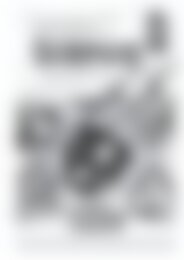6172RB Science a STEM approach Year 2 low res watermark
You also want an ePaper? Increase the reach of your titles
YUMPU automatically turns print PDFs into web optimized ePapers that Google loves.
Physical sciences<br />
FORCED TO MOVE<br />
Lesson 1<br />
Lesson plan<br />
Introduction:<br />
1. Divide students into pairs and give each pair a balloon. Students work together to move the<br />
balloon in as many different ways as they can. Prompt students by asking, How can you move your<br />
balloon from one partner to another? How can you move your balloon up into the air? How can you<br />
move your balloon down to the ground? How can you move your balloon from the floor to your<br />
waist? How can you move the balloon from the air to your waist? Students record each way they<br />
moved the balloon on a seperate sticky note and place each sticky note on their desk. QP PC<br />
PA<br />
2. After five minutes, stop the class and ask students to sort their sticky notes into two groups—push<br />
or pull (including gravity). Students fold a piece of A3 paper in half and label each half with either<br />
‘push’ or ‘pull’. Students attach the sorted sticky notes to each section to show examples of pushes<br />
and pulls. Students compare the examples in each section to answer What is a push? and What is a<br />
pull? QP PC PA<br />
Development:<br />
3. View the online video Gravity, force and work at . This video briefly<br />
explains how objects move when a person pushes or pulls them and how gravity acts on objects to<br />
pull them to the ground.<br />
4. Divide the class into groups of four and give each group a ball of playdough, four counters, four<br />
rulers and a copy of the pre-prepared cards on page 116. Ask one student to divide the playdough<br />
into quarters and give each student a piece of playdough, a ruler and a counter. Each student<br />
will need to break off a small amount of playdough to attach the counter to the desk so that the<br />
counter doesn’t move. As a group, students read the instructions on the first challenge card on<br />
page 116 and individually carry out the experiment. Note: Students must ensure they do not touch<br />
their playdough after the action has been performed. As a group, students discuss which type of<br />
force they applied to their playdough and compare what happened to each student’s playdough<br />
when force was applied. Students record a group answer for each question on the challenge card.<br />
Note: Students should tick all the changes that occured to the playdough when answering<br />
question 2. Using a digital camera or iPad®, students take a photograph of the card and the four<br />
pieces of playdough in their changed position, shape or size. Students collect their piece of<br />
playdough and repeat the process for the remaining challenges. PC PA E C<br />
Differentiation<br />
• Less capable students may be grouped together and assisted by an adult to read and discuss<br />
each challenge card.<br />
• More capable students may be encouraged to identify and test other ways they can use force to<br />
change the position, direction, shape or size of an object.<br />
5. If time al<strong>low</strong>s, students should be encouraged to upload their digital photographs to a computer,<br />
<strong>res</strong>ize them and insert all four photographs into a computer program, such as Microsoft® Word or<br />
PowerPoint, to create a poster. Students type their names onto the poster and print it.<br />
PC PA C<br />
Reflection:<br />
6. As a class, test students’ knowledge of forces using the Forces quiz at . Read the question aloud to the class and al<strong>low</strong> time for students to think about their<br />
answer. Note: The quiz creator website will ask you to join. On the right-hand side, click ‘Start without<br />
an account’. Alternatively, give each student a copy of page 117 to complete a hard copy version of<br />
the quiz. PA C<br />
© R.I.C. Publications<br />
Low <strong>res</strong>olution display copy<br />
R.I.C. Publications® – www.ricpublications.com.au 978-1-925431-95-7 YEAR <strong>Science</strong>:<br />
2 A <strong>STEM</strong> APPROACH 115


















